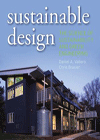...lowers a building’s carbon footprint. Building owners may choose to put solar panels on the roof instead of purchasing electricity from the grid. Others may opt to buy carbon offsets through renewable energy certificates or other programs.
A variety of energy models and load-calculation software, informed by practical experience, are used throughout the process. Typically, energy models are built in the early stages of design and then refined over time.
One such project she has under way is an art museum. “We probably will not meet LEED because the energy requirements are quite stringent,” Cousins says. “But that does not mean we should not aim to do the right thing for the environment and use the least amount of energy that we can in the way we are designing it.”
Other consulting projects are looking at how to integrate sustainability into master plans. A typical engagement starts with an exercise defining what sustainability means to the client.
Cousins says a sustainable master plan is not complete without looking at specific criteria, such as energy, water, wastes and materials. Planning sessions with the client include an ARUP team of people who understand and can think strategically about the specific areas.
The ultimate goal is to ensure that when the master plan gets implemented, the sustainability strategies remain in place, she says. “There are a lot of decisions that can’t be made on a building scale,” Cousins say. “They have to be made a couple of steps up the chain.”
A third type of sustainable consulting engagement was focusing on the organizational level and geared to helping a client transform activities to be more sustainable. Such work may encompass an entire enterprise or a subsection of an organization’s activities, such as a building portfolio.
One client she was dealing with wanted a completely sustainable organization, Cousins says. As with the master planning process, this type of effort starts by defining what sustainability means, which enables the team to design a sustainability framework. She says the framework tells designers what’s on and off the table.
Next, an assessment determines current activities that are, or are not, sustainable. A best-practices analysis, which looks at what other organizations are doing, is then used to create a plan for strategies and actions that the organization might take to move toward their sustainability goal.
“Sustainability plans of this type are much better if they are made with our assistance but then implemented internally,” Cousins says. “Sustainability has to become part of the culture of the organization, not just something the external consultant brings in when we show up for the weekly meetings.”
Beyond sustainability consulting, Cousins was directing a number of large construction projects, including a 250,000-sq-ft, four-story chemistry building for Princeton University. The facility will house classrooms, laboratory space and faculty and administrative offices. A sky-lit atrium connects the laboratory wing with the administrative offices.
The building is designed to conform to Princeton’s sustainability guidelines, which focus on lifecycle costs under a number of categories, such as water, energy and land use, as a means of understanding which sustainable strategies makes sense for a project. “It is quite a visionary process,” Cousins says.
She started working with the Princeton design team during the programming stage of the building. Now that the structure is under construction, she visits the project on a weekly basis to meet with the owner, constructor and architect to review the project status.
Beyond her responsibilities at ARUP, Cousins is involved with the U.S. Green Building Council’s New York Chapter, which she chaired for two years. Currently she is on the organization’s board, the Green Codes Task Force and the Green Construction Skills working group along with numerous committees.
For Cousins, the most challenging part of her job is switching from the tactical to the strategic, sometimes in 10-minute intervals and at other times in half-day intervals. She says she most enjoys the early stages of the design process and sustainability planning when ideas are still forming.
“I find that the whole process of defining, describing and prioritizing is incredibly rewarding,” she says.



